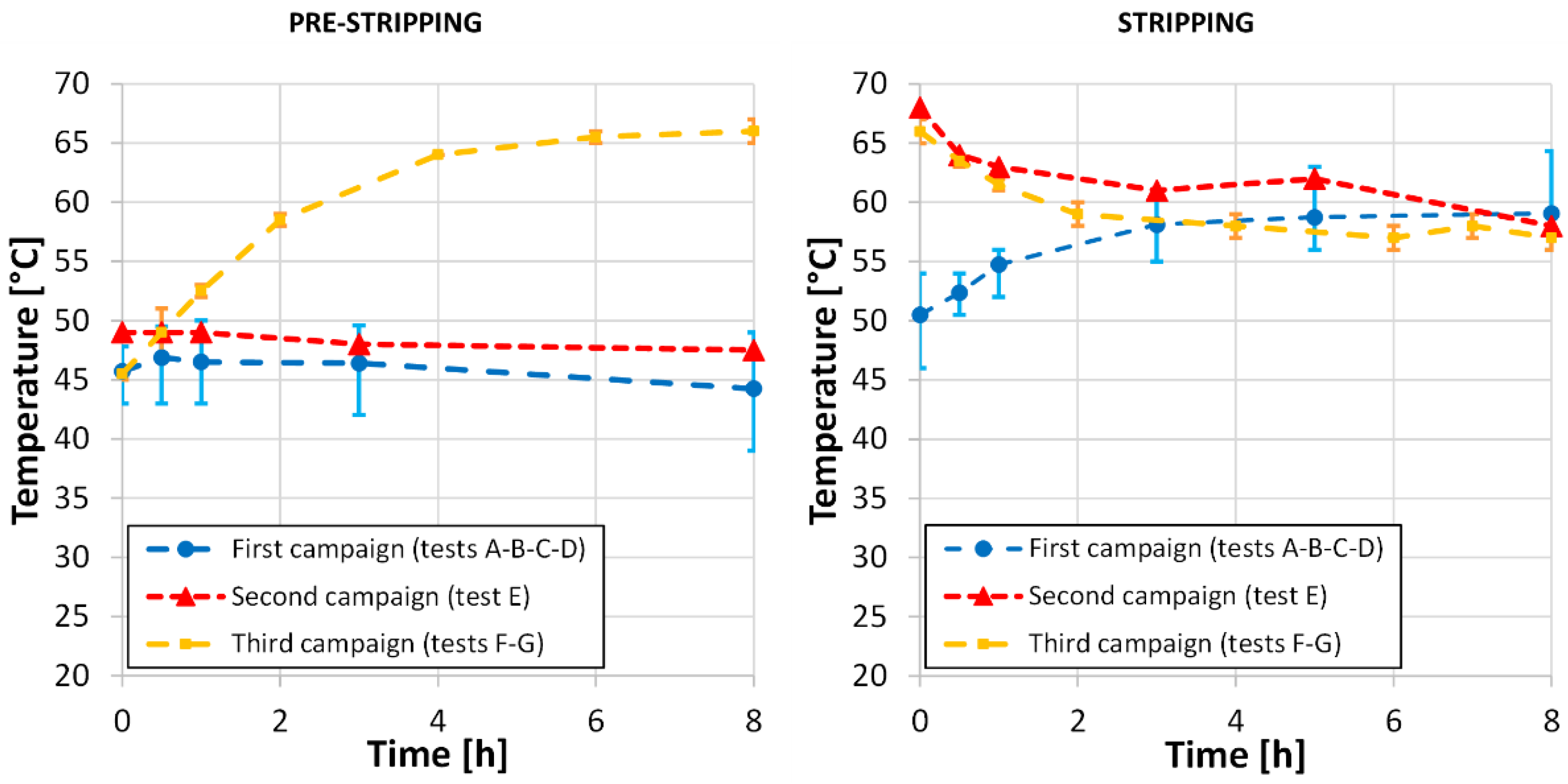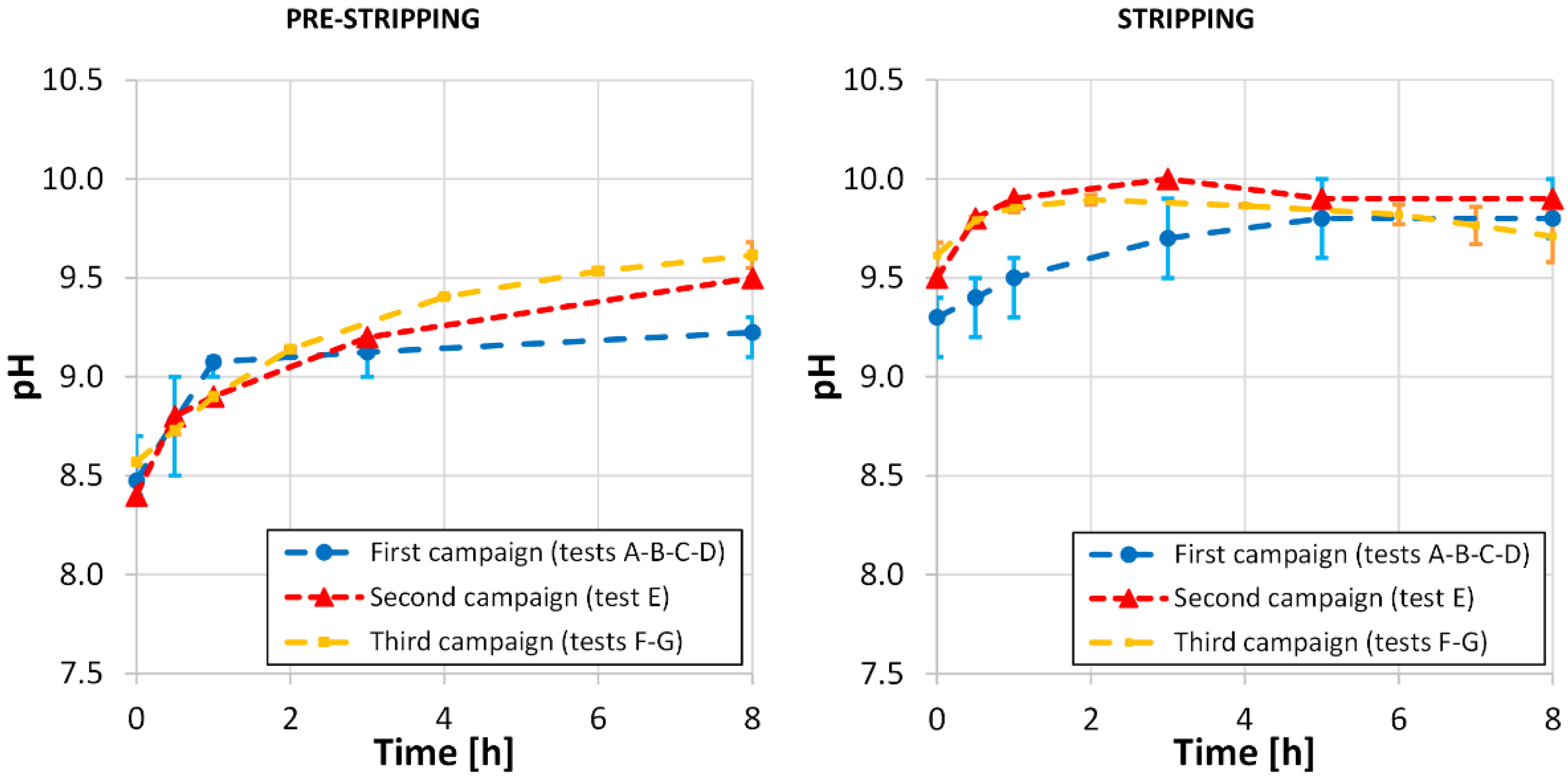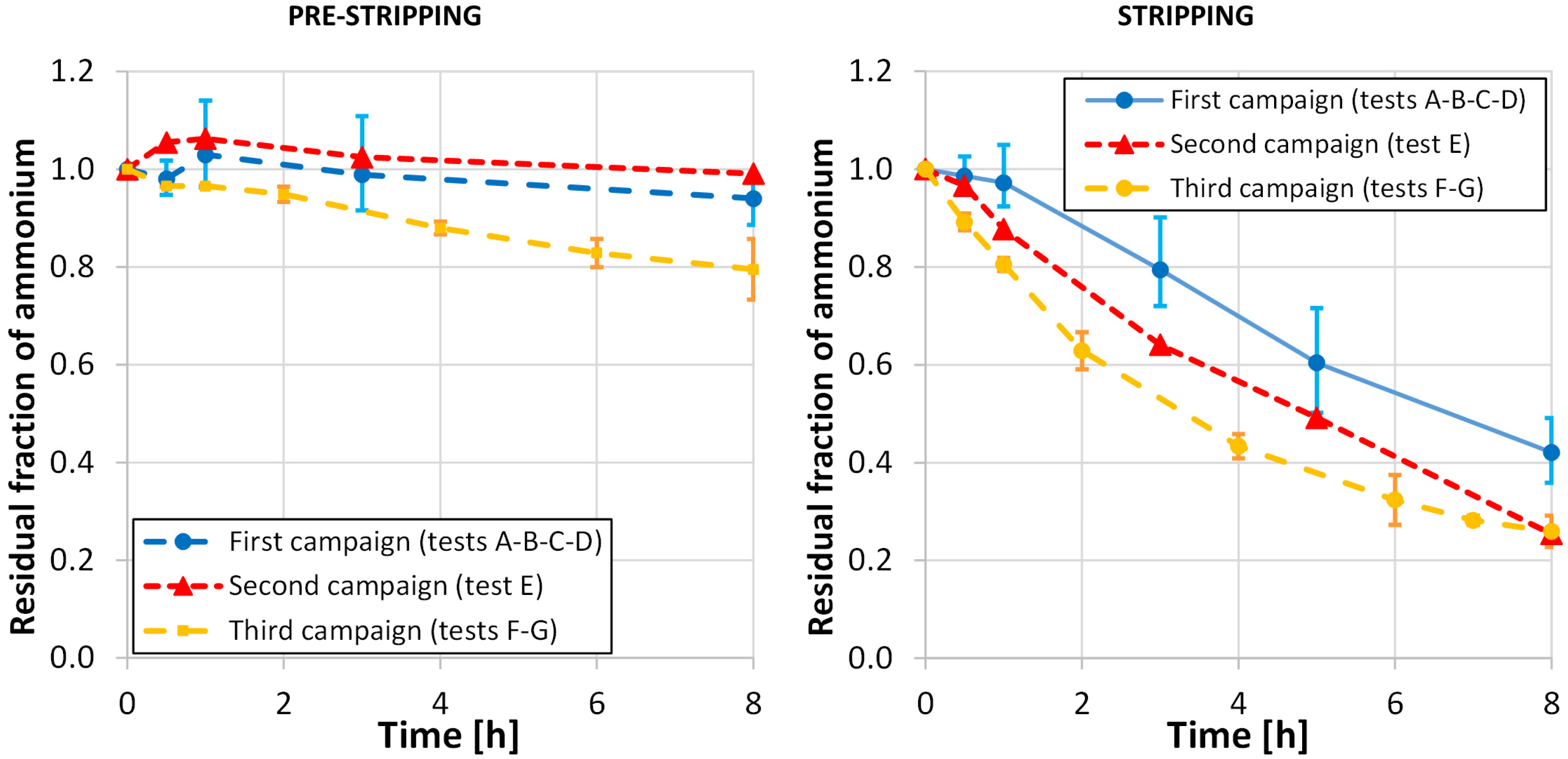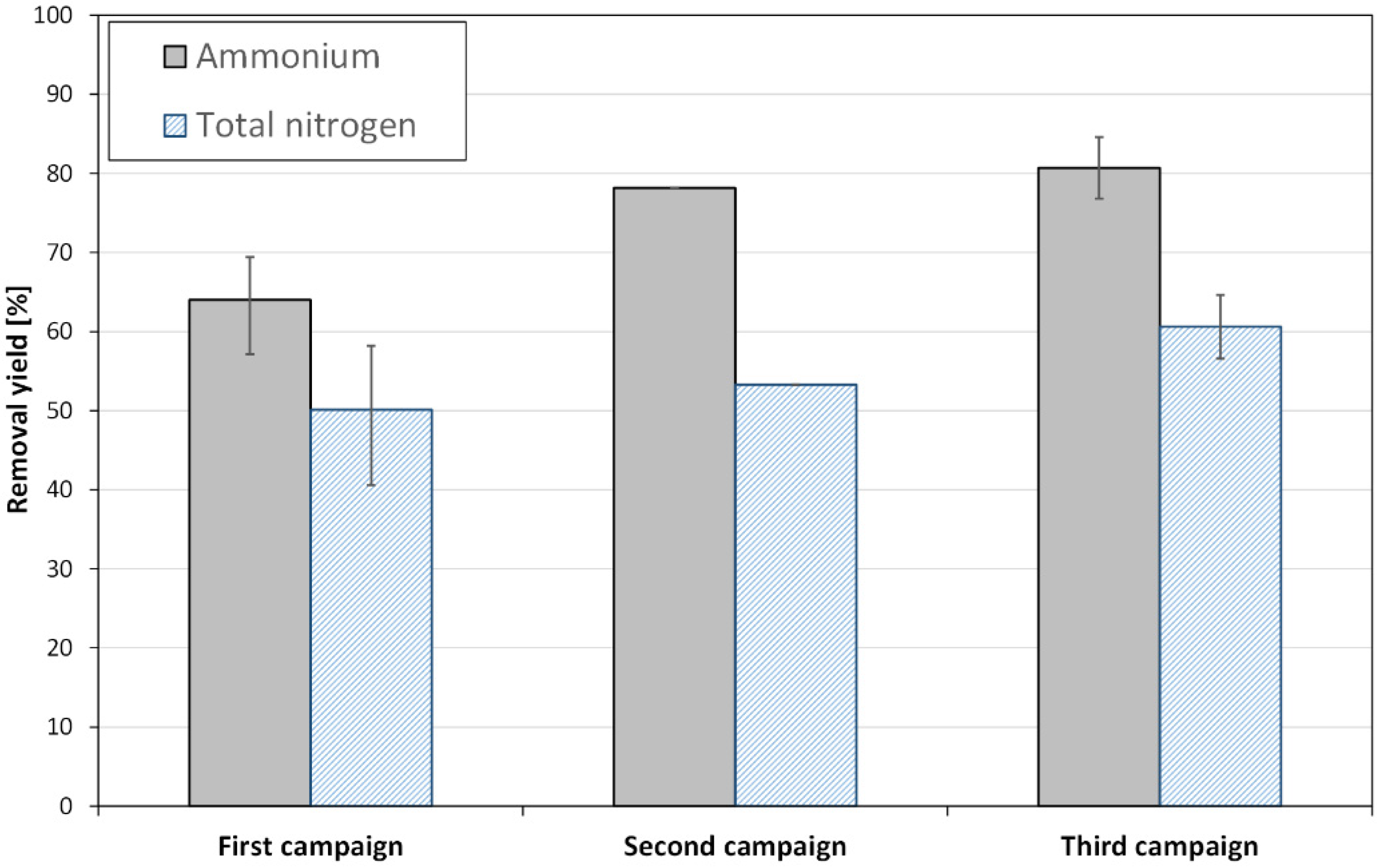Ammonia Recovery from Livestock Manure Digestate through an Air-Bubble Stripping Reactor: Evaluation of Performance and Energy Balance
Abstract
:1. Introduction
2. Materials and Methods
2.1. Description of the Study Site
- The anaerobic digesters fed mainly with swine manure (60 m3/d), corn silage (0.1 t/d) and beet molasses (0.14 t/d), with biogas production;
- The solid/liquid separation unit, separating the solid phase (recovered in agriculture) from the liquid phase (undergoing stripping);
- The stripping plant, with the production of ammonium sulphate for agriculture;
- The storage lagoons for the stabilization of the liquid digestate;
- The CHP unit, fed with biogas, for the production of electricity and heat reused in the ammonia-stripping reactor.
2.2. Description of the Ammonia-Stripping Plant
2.3. Operating Conditions and Plant Monitoring
- from the pre-stripping reactor (pS): from tap, 5 samples at different time intervals (0 h, 0.5 h, 1 h, 3 h, 8 h);
- from the stripping reactor (S): from tap, 5 samples at different time intervals (0 h, 0.5 h, 1 h, 3 h, 5 h, 8 h).
- from the pre-stripping reactor (pS): from tap, 7 samples at different time intervals (0 h, 0.5 h, 1 h, 2 h, 4 h, 6 h, 8 h);
- from the stripping reactor (S): from tap, 8 samples at different time intervals (0 h, 0.5 h, 1 h, 2 h, 4 h, 6 h, 7 h, 8 h).
- Vin is the volume of the manure fed to the reactors, equal to 14 m3;
- Vout is the volume of manure in the reactors at the end of the process, considering the evaporation. The details for the estimation of the evaporated volume are reported in the Supplementary Material.
2.4. Energy Balance
- The heating of the digestate mass in the stripping and/or pre-stripping reactor and, at a minimum, in the weighting tanks (Hm)—assuming that the specific heat of the digestate is equal to that of water;
- The compensation of heat dissipation from stripping and pre-stripping reactors to the external environment (Hd);
- The compensation of the latent heat of phase transition of the evaporating water (Hl);
- The heating of the air entering the blower (Ha); this was included in favour of safety, as the air is heated with the heat dissipated by the engine, which would not be transferred to the water recovery circuit.
3. Results
3.1. Nitrogen-Removal Efficiency
3.2. Mathematical Model of Ammonium Removal
3.3. Energy Balance
4. Discussion
- The temperature, during the pre-stripping phase, was kept around 40–45 °C, rising to about 60–65 °C in the subsequent stripping phase;
- Although no basifying reagent was dosed, the pH underwent an increase in the order of 1.1–1.3 points, to reach final values in the range 9.7–10.0;
- The ammonium was, overall, removed during the stripping process, with an average efficiency of 64%;
- The total nitrogen was, overall, removed with an average efficiency of 50%.
- The temperature of the digestate gradually rose to about 65 °C during the pre-stripping phase, and then lowered during the stripping phase, due to an insufficiency of the current heat-exchange system (although the heating power produced by the CHP could be sufficient);
- Although no basifying reagent was dosed, the pH underwent a significant increase (of the order of 1.2–1.3 points), to reach final values in the range 9.6–9.8;
- The average efficiency removal of ammonium during the stripping process was, overall, about 81%;
- The average efficiency removal for the total nitrogen was about 61%.
5. Conclusions
Supplementary Materials
Author Contributions
Funding
Data Availability Statement
Acknowledgments
Conflicts of Interest
References
- Pandey, B.; Chen, L. Technologies to recover nitrogen from livestock manure—A review. Sci. Total. Environ. 2021, 784, 147098. [Google Scholar] [CrossRef]
- Bogaard, A.; Fraser, R.; Heaton, T.H.E.; Wallace, M.; Vaiglova, P.; Charles, M.; Jones, G.; Evershed, R.P.; Styring, A.K.; Andersen, N.H.; et al. Crop manuring and intensive land management by Europe’s first farmers. Proc. Natl. Acad. Sci. USA 2013, 110, 12589–12594. [Google Scholar] [CrossRef] [PubMed]
- FAO; UNEP. Global Assessment of Soil Pollution: Report; FAO and UNEP: Rome, Italy, 2021. [Google Scholar] [CrossRef]
- Withers, P.J.A.; Neal, C.; Jarvie, H.P.; Doody, D.G. Agriculture and Eutrophication: Where Do We Go from Here? Sustainability 2014, 6, 5853–5875. [Google Scholar] [CrossRef]
- Webb, J.; Menzi, H.; Pain, B.F.; Misselbrook, T.H.; Dämmgen, U.; Hendriks, H.; Döhler, H. Managing ammonia emissions from livestock production in Europe. Environ. Pollut. 2005, 135, 399–406. [Google Scholar] [CrossRef] [PubMed]
- European Parliament and Council. Consolidated Text: Council Directive of 12 December 1991 Concerning the Protection of Waters against Pollution Caused by Nitrates from Agricultural Sources (91/676/EEC). 1991. Available online: https://eur-lex.europa.eu/legal-content/EN/TXT/?uri=celex%3A01991L0676-20081211 (accessed on 6 November 2022).
- Bousek, J.; Scroccaro, D.; Sima, J.; Weissenbacher, N.; Fuchs, W. Influence of the gas composition on the efficiency of ammonia stripping of biogas digestate. Bioresour. Technol. 2016, 203, 259–266. [Google Scholar] [CrossRef]
- Achinas, S.; Euverink, G.J.W. Rambling facets of manure-based biogas production in Europe: A briefing. Renew. Sustain. Energy Rev. 2020, 119, 109566. [Google Scholar] [CrossRef]
- Ferrari, G.; Ai, P.; Alengebawy, A.; Marinello, F.; Pezzuolo, A. An assessment of nitrogen loading and biogas production from Italian livestock: A multilevel and spatial analysis. J. Clean Prod. 2021, 317, 128388. [Google Scholar] [CrossRef]
- Cândido, D.; Chiapetti Bolsan, A.; Hollas, C.E.; Venturin, B.; Tápparo, D.C.; Bonassa, G.; Goldschmidt Antes, F.; Radis Steinmetz, R.L.; Bortoli, M.; Kunz, A. Integration of swine manure anaerobic digestion and digestate nutrients removal/recovery under a circular economy concept. J. Environ. Manag. 2022, 301, 113825. [Google Scholar] [CrossRef]
- Risberg, K.; Cederlund, H.; Pell, K.; Arthurson, V.; Schnürer, A. Comparative characterization of digestate versus pig slurry and cow manure—Chemical composition and effects on soil microbial activity. Waste Manag. 2017, 61, 529–538. [Google Scholar] [CrossRef] [PubMed]
- Provenzano, M.R.; Iannuzzi, G.; Fabbri, C.; Senesi, N. Qualitative Characterization and Differentiation of Digestates from Different Biowastes Using FTIR and Fluorescence Spectroscopies. J. Environ. Prot. 2011, 2, 83–89. [Google Scholar] [CrossRef]
- Hou, Y.; Velthof, G.L.; Lesschen, J.P.; Staritsky, I.G.; Oenema, O. Nutrient Recovery and Emissions of Ammonia, Nitrous Oxide, and Methane from Animal Manure in Europe: Effects of Manure Treatment Technologies. Environ. Sci. Technol. 2017, 51, 375–383. [Google Scholar] [CrossRef] [PubMed]
- Dadrasnia, A.; de Bona Muñoz, I.; Yáñez, E.H.; Lamkaddam, I.U.; Mora, M.; Ponsá, S.; Ahmed, M.; Argelaguet, L.L.; Williams, P.M.; Oatley-Radcliffe, D.L. Sustainable nutrient recovery from animal manure: A review of current best practice technology and the potential for freeze concentration. J. Clean Prod. 2021, 315, 128106. [Google Scholar] [CrossRef]
- Macura, B.; Johannesdottir, S.L.; Piniewski, M.; Haddaway, N.R.; Kvarnström, E. Effectiveness of ecotechnologies for recovery of nitrogen and phosphorus from anaerobic digestate and effectiveness of the recovery products as fertilisers: A systematic review protocol. Environ. Evid. 2019, 8, 29. [Google Scholar] [CrossRef]
- Zarebska, A.; Romero Nieto, D.; Christensen, K.V.; Fjerbæk Søtoft, L.; Norddahl, B. Ammonium fertilizers production from manure: A critical review. Crit. Rev. Environ. Sci. Technol. 2015, 45, 1469–1521. [Google Scholar] [CrossRef]
- Drosg, B.; Fuchs, W.; Al Seadi, T.; Madsen, M.; Linke, B. Nutrient Recovery by Biogas Digestate Processing; Baxter, D., Ed.; IEA Bioenergy: Paris, France, 2015; ISBN 978-1-910154-16-8. [Google Scholar]
- Gong, H.; Yan, Z.; Liang, K.Q.; Jin, Z.Y.; Wang, K.J. Concentrating process of liquid digestate by disk tube-reverse osmosis system. Desalination 2013, 326, 30–36. [Google Scholar] [CrossRef]
- Yilmazel, Y.D.; Demirer, G.N. Removal and recovery of nutrients as struvite from anaerobic digestion residues of poultry manure. Environ. Technol. 2011, 32, 783–794. [Google Scholar] [CrossRef] [PubMed]
- Shi, L.; Simplicio, W.S.; Wu, G.; Hu, Z.; Hu, H.; Zhan, X. Nutrient Recovery from Digestate of Anaerobic Digestion of Livestock Manure: A Review. Curr. Pollut. Rep. 2018, 4, 74–83. [Google Scholar] [CrossRef]
- Uysal, A.; Yilmazel, Y.D.; Demirer, G.N. The determination of fertilizer quality of the formed struvite from effluent of a sewage sludge anaerobic digester. J. Hazard Mater. 2010, 181, 248–254. [Google Scholar] [CrossRef] [PubMed]
- Limoli, A.; Langone, M.; Andreottola, G. Ammonia removal from raw manure digestate by means of a turbulent mixing stripping process. J. Environ. Manag. 2016, 176, 1–10. [Google Scholar] [CrossRef]
- Provolo, G.; Perazzolo, F.; Mattacchini, G.; Finzi, A.; Naldi, E.; Riva, E. Nitrogen removal from digested slurries using a simplified ammonia stripping technique. Waste Manag. 2017, 69, 154–161. [Google Scholar] [CrossRef]
- Baldi, M.; Collivignarelli, M.C.; Abbà, A.; Benigna, I. The Valorization of Ammonia in Manure Digestate by Means of Alternative Stripping Reactors. Sustainability 2018, 10, 3073. [Google Scholar] [CrossRef]
- Vazifehkhoran, A.H.; Finzi, A.; Perazzolo, F.; Riva, E.; Ferrari, O.; Provolo, G. Nitrogen Recovery from Different Livestock Slurries with an Innovative Stripping Process. Sustainability 2022, 14, 7709. [Google Scholar] [CrossRef]
- Bonmatì, A.; Campos, E.; Flotats, X. Concentration of pig slurry by evaporation: Anaerobic digestion as the key process. Water Sci. Technol. 2003, 48, 189–194. [Google Scholar] [CrossRef] [PubMed]
- Guercini, S.; Castelli, G.; Rumor, C. Vacuum evaporation treatment of digestate: Full exploitation of cogeneration heat to process the whole digestate production. Water Sci. Technol. 2014, 70, 479–485. [Google Scholar] [CrossRef]
- Lauterbock, B.; Moder, K.; Germ, T.; Fuchs, W. Impact of characteristic membrane parameters on the transfer rate of ammonia in membrane contactor application. Sep. Purif. Technol. 2013, 116, 327–334. [Google Scholar] [CrossRef]
- Sürmeli, R.Ö.; Bayrakdar, A.; Çallia, B. Ammonia recovery from chicken manure digestate using polydimethylsiloxane membrane contactor. J. Clean Prod. 2018, 191, 99–104. [Google Scholar] [CrossRef]
- Collivignarelli, M.C.; Abbà, A.; Bertanza, G. Why use a thermophilic aerobic membrane reactor for the treatment of industrial wastewater/liquid waste? Environ. Technol. 2015, 36, 2115–21124. [Google Scholar] [CrossRef] [PubMed]
- Collivignarelli, M.C.; Bertanza, G.; Abbà, A.; Sordi, M.; Pedrazzani, R. Synergy between anaerobic digestion and a post-treatment based on Thermophilic Aerobic Membrane Reactor (TAMR). Environ. Prog. Sustain. Energy 2017, 36, 1802–1809. [Google Scholar] [CrossRef]
- Palakodeti, A.; Azman, S.; Rossi, B.; Dewil, R.; Appels, L. A critical review of ammonia recovery from anaerobic digestate of organic wastes via stripping. Renew. Sustain. Energy Rev. 2021, 143, 110903. [Google Scholar] [CrossRef]
- Yang, D.; Chen, Q.; Liu, R.; Song, L.; Zhang, Y.; Dai, X. Ammonia recovery from anaerobic digestate: State of the art, challenges and prospects. Bioresour. Techno. 2022, 363, 127957. [Google Scholar] [CrossRef] [PubMed]
- Vaneeckhaute, C.; Lebuf, V.; Michels, E.; Belia, E.; Vanrolleghem, P.A.; Tack, F.M.; Meers, E. Nutrient recovery from digestate: Systematic technology review and product classification. Waste Biomass Valor. 2017, 8, 21–40. [Google Scholar] [CrossRef]
- Barampouti, E.M.; Mai, S.; Malamis, D.; Moustakas, K.; Loizidou, M. Exploring technological alternatives of nutrient recovery from digestate as a secondary resource. Renew. Sustain. Energy Rev. 2020, 134, 110379. [Google Scholar] [CrossRef]
- Monfet, E.; Aubry, G.; Ramirez, A.A. Nutrient removal and recovery from digestate: A review of the technology. Biofuels 2018, 9, 247–262. [Google Scholar] [CrossRef]
- DIVAPRA; IPLA; ARPA. Metodi di Analisi del Compost: Determinazioni Chimiche, Fisiche, Biologiche e Microbiologiche; Analisi Merceologica dei Rifiuti; Collana Ambiente n.6; Regione Piemonte, Assessorato all’Ambiente: Turin, Italy, 1998. (In Italian) [Google Scholar]
- IRSA-CNR. Metodi Analitici per i Fanghi—Parametri Tecnologici; Quaderni dell’Istituto di Ricerca Sulle Acque: Rome, Italy, 1984; p. 64. (In Italian) [Google Scholar]
- Zeb, I.; Zheng, Y.-M.; Zhao, Q.-B.; Chen, S.; Frear, C.; Yu, L.; Ma, J. Ammonia recovery from anaerobic digester effluent through direct aeration. Chem. Eng. J. 2015, 279, 31–37. [Google Scholar] [CrossRef]
- Zeng, L.; Mangan, C.; Li, X. Ammonia recovery from anaerobically digested cattle manure by steam stripping. Water Sci. Technol. 2006, 54, 137–145. [Google Scholar] [CrossRef]
- De Nevers, N. Appendix A: Useful Tables and Charts. In Physical and Chemical Equilibrium for Chemical Engineers; John Wiley & Sons: Hoboken, NJ, USA, 2012. [Google Scholar] [CrossRef]





| Ammonia Recovery Method | Main Advantages | Main Limitations | Selected References |
|---|---|---|---|
| Ammonia stripping |
|
| [32,33,34,35,36] |
| Membrane Separation |
|
| [20,33,35,36] |
| Struvite precipitation |
|
| [33,35,36] |
| Ion exchange And absorption |
|
| [20,34,35] |
| Evaporation |
|
| [20,35] |
| Thermophilic aerobic Membrane reactor |
|
| [30,31] |
| Campaign | Test | Operating Conditions | ||
|---|---|---|---|---|
| Reactors’ Modes of Functioning | Heat Settings | Monitoring Time [h] | ||
| First | A, B, C, D | Pre-stripping and stripping reactors working simultaneously | Pre-stripping reactor not heated, stripping reactor heated (starting from the temperature of the pre-stripping one) | 8 |
| Second | E | Pre-stripping and stripping reactors working simultaneously | Pre-stripping reactor not heated, stripping reactor heated (setting the initial temperature equal to 68 °C) | 8 |
| Third | F, G | One reactor working in pre-stripping and then in stripping | Heating activated at the beginning of the pre-stripping phase | 16 |
| Campaign | pH | Residue at 105 °C [% as is] | Residue at 600 °C [% as is] | Ntot [mg/L] | N-NH4+ [mg/L] |
|---|---|---|---|---|---|
| First | 8.5 ± 0.1 | 2.0 ± 0.2 | 0.9 ± 0.2 | 3569.0 ± 422.3 | 2890.0 ± 376.9 |
| Second | 8.4 | 1.4 | 0.8 | 2786.0 | 2234.0 |
| Third | 8.5 ± 0.1 | n.a. | n.a. | 3300.0 ± 141.4 | 2900.0 ± 141.4 |
| Test | Operating Conditions | Time Interval [h] | Time-Weighted Average T [°C] | Time-Weighted Average pH | Qair [Nm3/h] | (N-NH4+)0 [mg/L] | k [h−1] |
|---|---|---|---|---|---|---|---|
| D | Pre-stripping | 1–8 | 41.07 | 9.17 | 210 | 3367.5 | 0.006 |
| C | Pre-stripping | 1–8 | 44.30 | 9.15 | 210 | 3052.8 | 0.021 |
| B | Pre-stripping | 0.5–8 | 47.83 | 9.21 | 210 | 2418.6 | 0.012 |
| B | Pre-stripping | 0.5–3 | 48.50 | 9.13 | 210 | 2441.5 | 0.023 |
| E | Pre-stripping | 0.5–3 | 48.60 | 9.01 | 210 | 2371.7 | 0.014 |
| A | Pre-stripping | 1–8 | 49.44 | 9.07 | 210 | 3001.4 | 0.011 |
| F | Pre-stripping | 4–8 | 64.75 | 9.50 | 210 | 2603.0 | 0.042 |
| D | Stripping | 3–8 | 56.10 | 9.98 | 840 | 1940.3 | 0.075 |
| G | Stripping | 6–8 | 56.50 | 9.67 | 840 | 863.1 | 0.126 |
| C | Stripping | 1–8 | 56.57 | 9.72 | 840 | 1957.9 | 0.091 |
| F | Stripping | 2–7 | 58.90 | 9.87 | 840 | 1267.4 | 0.165 |
| B | Stripping | 3–8 | 59.90 | 9.78 | 840 | 1768.4 | 0.130 |
| E | Stripping | 0.5–5 | 61.94 | 9.94 | 840 | 1930.0 | 0.150 |
| Campaigns | Test | Electric Power Required by the Process [kWel] | Electric Power Produced by the CHP Unit [kWel] | Maximum Heating Power Required by the Process [kWth] | Heating Power Produced by the CHP Unit [kWth] |
|---|---|---|---|---|---|
| First | A | 17.8 | n.a. | 143 | n.a. |
| B | 17.8 | 221 | 166 | 272 | |
| C | 17.8 | 154 | 127 | 189 | |
| D | 17.8 | 190 | 138 | 233 | |
| Second | E | 17.8 | n.a. | n.a. | n.a. |
| Third | F | 17.8 | 217 | 222 | 267 |
| G | 17.8 | 191 | 214 | 235 |
Disclaimer/Publisher’s Note: The statements, opinions and data contained in all publications are solely those of the individual author(s) and contributor(s) and not of MDPI and/or the editor(s). MDPI and/or the editor(s) disclaim responsibility for any injury to people or property resulting from any ideas, methods, instructions or products referred to in the content. |
© 2023 by the authors. Licensee MDPI, Basel, Switzerland. This article is an open access article distributed under the terms and conditions of the Creative Commons Attribution (CC BY) license (https://creativecommons.org/licenses/by/4.0/).
Share and Cite
Abbà, A.; Domini, M.; Baldi, M.; Pedrazzani, R.; Bertanza, G. Ammonia Recovery from Livestock Manure Digestate through an Air-Bubble Stripping Reactor: Evaluation of Performance and Energy Balance. Energies 2023, 16, 1643. https://doi.org/10.3390/en16041643
Abbà A, Domini M, Baldi M, Pedrazzani R, Bertanza G. Ammonia Recovery from Livestock Manure Digestate through an Air-Bubble Stripping Reactor: Evaluation of Performance and Energy Balance. Energies. 2023; 16(4):1643. https://doi.org/10.3390/en16041643
Chicago/Turabian StyleAbbà, Alessandro, Marta Domini, Marco Baldi, Roberta Pedrazzani, and Giorgio Bertanza. 2023. "Ammonia Recovery from Livestock Manure Digestate through an Air-Bubble Stripping Reactor: Evaluation of Performance and Energy Balance" Energies 16, no. 4: 1643. https://doi.org/10.3390/en16041643
APA StyleAbbà, A., Domini, M., Baldi, M., Pedrazzani, R., & Bertanza, G. (2023). Ammonia Recovery from Livestock Manure Digestate through an Air-Bubble Stripping Reactor: Evaluation of Performance and Energy Balance. Energies, 16(4), 1643. https://doi.org/10.3390/en16041643











